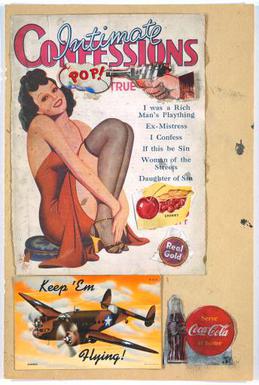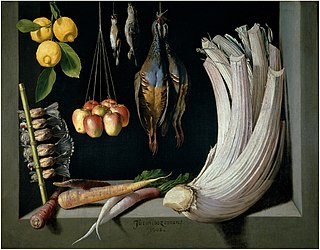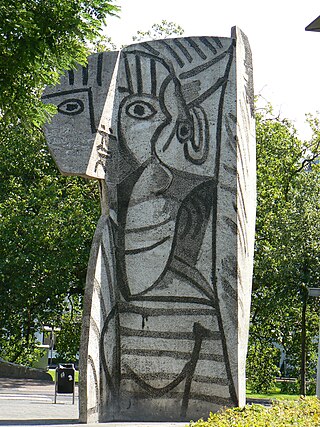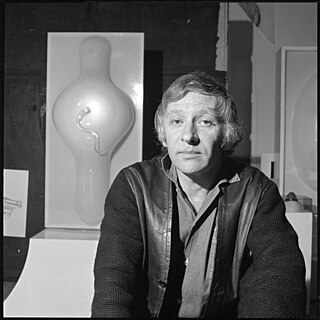
Wilhelmus Josephus (Woody) van Amen (Eindhoven August 26, 1936) is a Dutch sculptor, painter and collage artist. [1]

Wilhelmus Josephus (Woody) van Amen (Eindhoven August 26, 1936) is a Dutch sculptor, painter and collage artist. [1]
Van Amen studied at the Rotterdam Academy. His teachers included Louis van Roode . From 1970 he taught at the same Academy. In 1959 he made the longest paintings in the world, [2] which were abstract paintings made on organ books.
From 1961 he spent two years in the United States. He was introduced to the work of American artists such as Andy Warhol and Robert Rauschenberg, pioneers in the pop art movement. These artists used everyday consumer objects in their work. Van Amen drew inspiration from this approach and made a number of paintings in which he incorporated familiar brands from the Netherlands.
Back in the Netherlands, he developed his own style and at one point moved on to using other techniques. He devoted himself to assemblage art. He made his works from a variety of objects taken from everyday life. He created art that was intended to shock the establishment. For example, his work Electric Chair from 1964 was an assemblage piece made of waste wood and had everything necessary for the execution of the death sentence. At the same time it looks clumsy and too cozy with a flower pot full of geraniums. The public reaction to the work was negative and the work was not regarded as art but as mockery. The work was rejected for an exhibition in Schiedam. [3]
The period 1966-1967 saw a change in the themes prevalent in Woody van Amen's work. The new work involved a study of the visual aspects of movement, light and light reflection. The artist also started to experiment with new materials such as perspex and neon.
In 1968 Woody van Amen started to experiment with ice. He took a freezer apart and reassembled it inside out. A beautiful coat of white frost formed on the modified shape of the cooling element.
Woody van Amen also made a series of "Vibro-objects" intended as an ironic take on consumer society. He modified the weight loss devices of that time so that they were completely deprived of their function and became components of large torture instruments made of cold chrome. The steel springs that were attached to the devices vibrated so that the whole resembled fat western bodies that were trembling and shivering. [4]
In the 1970s he started to make frequent trips to Switzerland and Southeast Asia, which is the basis of an oriental influence in his work. His art moved away from pop art and became difficult to classify. He started using a few recurring forms in his works such as the Matterhorn and a form he refers to as the taxat, which is based on an Oriental symbol.

In 1993 he was the recipient of the Chabot Prize which is awarded by the Prins Bernhard Cultuurfonds (Prince Bernhard Culture Fund). [5] Museum Valkhof organised in 2003 a retrospective of his work [6] and a catalogue raisonné of his work was published.
After recovering from a serious illness, he visited Singapore in 2003 where he came upon flashcards of Chinese characters. Chinese characters, particularly the characters shuangxi or "double happiness" (喜喜) (usually associated with Chinese weddings), have since played an important role in his work. [7]
In 2007, van Amen made the film Sources of Inspiration. It records his travels to Vietnam, Burma and Indonesia. Man, religion and the beauty of nature play an important role in the film. Rotterdam based art centre Tent organised the large duo exhibition New Romantic Spirit of van Amen and the Dutch artist Hidde van Schie. [8]

Pop art is an art movement that emerged in the United Kingdom and the United States during the mid- to late-1950s. The movement presented a challenge to traditions of fine art by including imagery from popular and mass culture, such as advertising, comic books and mundane mass-produced objects. One of its aims is to use images of popular culture in art, emphasizing the banal or kitschy elements of any culture, most often through the use of irony. It is also associated with the artists' use of mechanical means of reproduction or rendering techniques. In pop art, material is sometimes visually removed from its known context, isolated, or combined with unrelated material.

A still life is a work of art depicting mostly inanimate subject matter, typically commonplace objects which are either natural or human-made.

Assemblage is an artistic form or medium usually created on a defined substrate that consists of three-dimensional elements projecting out of or from the substrate. It is similar to collage, a two-dimensional medium. It is part of the visual arts and it typically uses found objects, but is not limited to these materials.

Sylvette is a large concrete sculpture created by Pablo Picasso and the Norwegian artist Carl Nesjar, which was erected in the city of Rotterdam in 1970. It is located on the corner of Westersingel next to the Museum Boijmans Van Beuningen. The sculpture portrays a young woman with a ponytail. The model for the sculpture was Sylvette David, whom Picasso met in 1953 when she was 19. The sculpture was produced following the creation of a series of artworks, known as the Sylvette series, that Picasso made of his muse in a variety of artistic styles.

Willem Kalf was one of the most prominent Dutch still-life painters of the 17th century, the Dutch Golden Age. We first get acquainted with Willem Kalf through Arnold Houbraken, in his Groot Schilderboek, who speaks very highly of him. In fact, Kalf was a highly regarded and celebrated artist during his own lifetime. This was due to his extensive art knowledge and what we gain from Houbraken, his affable personality. His claim to fame now rests mostly on his mature still lifes, pronkstilleven in Dutch, which feature the most exotic and luxurious objects. This can be seen in for example, Still life with nautilus beaker and porcelain lidded bowl from 1662, which became an iconic piece of western art.
Ronnie Cutrone was an American pop artist known for his large-scale paintings of some of America's favorite cartoon characters, such as Felix the Cat, Pink Panther, Woody Woodpecker and No Glove No Love.

The Willem de Kooning Academy is a Dutch academy of media, art, design, leisure and education based in Rotterdam. It was named after one of its most famous alumni, Dutch fine artist Willem de Kooning.
C-Space Beijing is a contemporary art gallery in the artist district of Caochangdi, in Beijing China.

The Valkhof at Nijmegen is an oil painting by the Dutch Golden Age painter Aelbert Cuyp, likely painted between 1652 and 1654. It is now held in the Indianapolis Museum of Art.

Miguel-Ángel Cárdenas, also known as Michel Cardena, was a Colombian-Dutch, New Realism and Pop Art painter and a pioneer of video art in the Netherlands. His works cover a variety of artistic media, including painting, drawing, video, photography, object assemblages and digital art.

Han Schuil is a Dutch multimedia artist, who works in a Dutch tradition of compactness and tension in painting.

Daan Samson is a Dutch artist. His work deals with taboos, embarrassments and achievements of the welfare state.

Berend Strik is a Dutch visual artist working and living in Amsterdam.

David Johannes van de Kop or David Vandekop was a Dutch painter, draftsman and sculptor.
Daniël (Daan) van Golden was a Dutch artist, who has been active as a painter, photographer, collagist, installation artist, wall painter and graphic artist. He is known for his meticulous paintings of motives and details of everyday life and every day images.

Matheus Josephus Lambertus (Mathieu) Ficheroux was a Dutch artist, who worked as sculptor, glass painter, painter, draftsman, wall painter and installation artist. He is considered among the foremost Dutch artist of the second part of the 20th century.

The Dutch Nul Group, which consisted of Armando, Jan Henderikse, Henk Peeters and Jan Schoonhoven (1914-1994), manifested itself in form and name in 1961. On 1 April 1961, a stone's throw from the Amsterdam Stedelijk Museum, Galerie 201 organized the ‘Internationale tentoonstelling van NIETS’. The 'Manifest tegen niets' and 'Einde' ('Ending'), a pamphlet published at the same time, were among the first activities of the Nul group. ‘We need art like we need a hole in the head,’ the pamphlet 'Einde' states; ‘From now on the undersigned pledge to work to disband art circles and close down exhibition facilities, which can then finally be put to worthier use.’ The 'Einde' pamphlet imagines a new beginning, as Armando and Henk Peeters had already proclaimed in texts written several years earlier for the Dutch Informals.
Meschac Gaba is a Beninese conceptual artist based in Rotterdam and Cotonou. His installations of everyday objects whimsically juxtapose African and Western cultural identities and commerce. He is best known for The Museum of Contemporary African Art 1997–2002, an autobiographical 12-room installation acquired and displayed by the Tate Modern in 2013. He has also exhibited at the Studio Museum in Harlem and at the 2003 Venice Biennale.

Paul Beumer is a Dutch artist. His non-traditional artistic process includes manual resist-dyeing techniques to create abstract patterns which are described as a reminiscent of "Western High Modernism in that they allow for doubt, failure and chance." Beumer, himself, describes his works as “humble and simple in its forms.” He is presently a resident at 16/16 in Lagos, Nigeria and Schoolhouse in Mutianyu, China.

Cornelis Bastiaan Vaandrager, who generally published with only his initials as C. B. Vaandrager, was a Dutch writer and poet who lived and worked in Rotterdam. Later he came to be known simply by the shortened version of his name as Vaan.